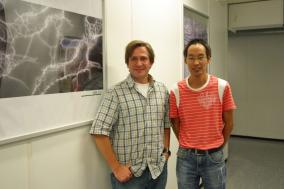Electron Microscopy
We use the term analytical electron microscopy for our advanced characterization work in the fields of scanning and transmission electron microcopy. These two characterization techniques are central to all our research activities. The key properties of all structural and functional engineering materials are governed by microstructures, with characteristic length scales in the nm range. This applies to many of the systems we investigate, such as single crystal superalloys, advanced steels, shape memory alloys and high-entropy alloys. The key features of these fine microstructures can only be revealed by transmission electron microscopy. The spatial orientations of fine crystals in polycrystalline structures can only be assessed using high-resolution orientation imaging scanning electron microscopes. In our Chair for Materials Science and Engineering, we combine our knowledge of thermodynamics, kinetics, mechanical properties and microstructures of materials with advanced electron microscopy methods. They are complex, time-consuming and expensive, as far as costs and experimental efforts are concerned. However, these methods are indispensable in modern materials science research.
For advanced electron microscopy, an infrastructure is required that allows the production of high-quality specimens for investigations. Our group has and provides such an infrastructure. It can be used by the members of our group and by other researchers from our university. Most of our research objectives could not be achieved if we were limited to a user status in a multi-user microscopy facility. We need long-term access of dedicated instruments. Advanced students and doctoral students need to be trained on the instruments and introduced to the various techniques. Electron microscopy must also be appropriately represented in the materials curriculum offered by our institute. Our electron microscopy group provides input for many other groups from inside and outside of our university.
In our group, Christoph Somsen is responsible for transmission electron microscopy. He closely collaborates with Antonin Dlouhý, who is our Adjunct Professor for defect analysis in the transmission electron microscope. Christoph Somsen and Antonin Dlouhý offer classes on basic and advanced topics of transmission electron microscopy. Christoph Somsen closely collaborates with Aleksander Kostka from the ZGH, who looks after the microscopy facilities there. Together, Christoph Somsen (coordinator) and Aleksander Kostka (technical advisor) have written several successful applications for expensive microscopes and support infrastructure.
Two new transmission electron microscopes were purchased from Jeol, one was installed in our group; the other is for the ZGH. The start-up of these systems and their timely integration into our running research projects required additional support. This is why we have made an effort to reattract Alireza Basir Parsa to our group. He is a TEM scientist, who did his PhD work in our group, using quantitative TEM to study interfaces in superalloys and surface regions after reciprocal lateral wear.
The scanning electron microscopy of our Chair is taken care of by Norbert Lindner. In teaching and research, Jan Frenzel and Pascal Thome represent this field.
In our department, all research areas benefit from the activities in the electron microscopy group, which is strongly interlinked with all other research groups.



